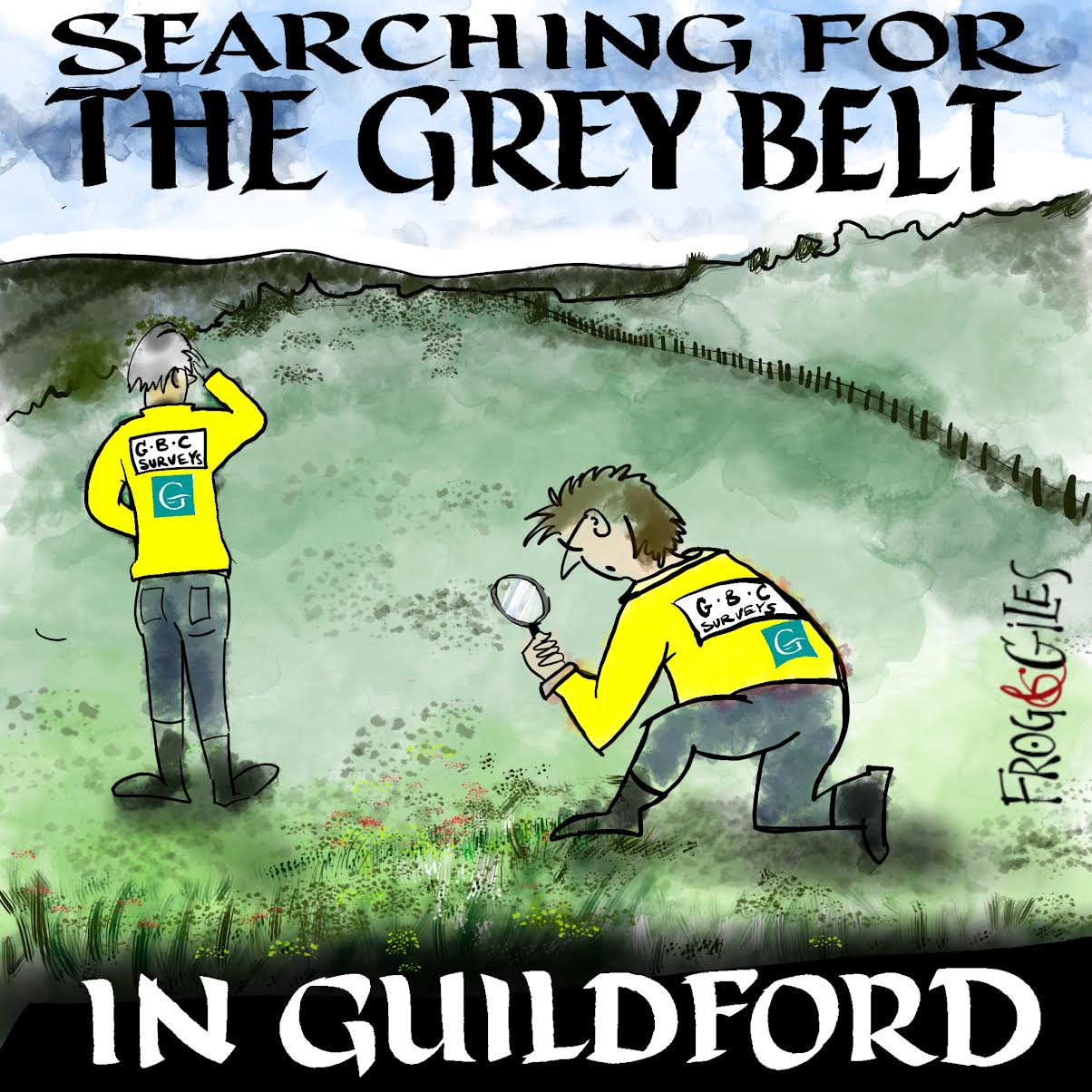 Abraham Lincoln
If given the truth, the people can be depended upon to meet any national crisis...
Abraham Lincoln
If given the truth, the people can be depended upon to meet any national crisis...
 Guildford news...
for Guildford people, brought to you by Guildford reporters - Guildford's own news service
Guildford news...
for Guildford people, brought to you by Guildford reporters - Guildford's own news service
Letter: Green Belt Will Be Needed For Housing
Published on: 3 Aug, 2016
Updated on: 4 Aug, 2016
Hon Alderman and former mayor
Cllr Paul Spooner [GBC council leader] in his letter Planning Inspector Will See CPRE’s Comments, Along With All Others has sought to open a debate and should be given credit for that.
What I find interesting is none of the seven objecting letters address the main problem raised, that of a serious housing problem. All are concerned about the percentage of green belt land which might be needed. Fair enough, but what about solving the housing crisis?
While concern and protection of our green belt land is important surely providing affordable houses for a younger generation is far more important?
The new minister for local government was surely irresponsible in claiming, if he did say it, that the “green belt is sacrosanct”. It seems to me this was an a judgement which ignores social and economic needs.
The debate should be about how many houses we need, where they should go and how we can make them affordable for the younger generation who do not have wealthy parents ?
We have been fortunate in one way in Guildford in having hard working immigrants propping up many of our services and they are doing this in institutional accommodation or in substandard housing.
Young British people cannot afford our housing prices or are not prepared to accept conditions caused by high land costs. As a result, our hospital, our schools and even GBC find it very difficult to find staff.
Even more important the high tech enterprises, which account for us being an economically successful, cannot attract the staff they need.
Of course, there is land available for housing in the town centre which in my view the Guildford Plan is mistakenly proposing should be used mainly for retail (45,000 sq metres – 40% of existing) but this is high cost land with planning permission and while some houses are proposed this is not a site suitable for younger people with families.
These sites should be allocated for high quality housing for elderly people who are required to make a contribution towards affordable family housing in more suitable locations. And any new buildings should be in scale and character.
Funding “affordable” housing is one real problem as the government restricts the traditional council approach. The only practical solution is to secure community funding from the development of the three strategic sites the council identifies in their Plan – Blackwell Farm, Wisley and Gosden – these areas together are less than 1.6% of green belt land.
The council’s 40% target of “affordable” homes, which seems to have been widely acceptable, may be desirable but seems very optimistic. Since the housing target has yet to be formally agreed it would seem premature to identify locations but the areas suggested are likely to be the only ones which can go a reasonable way to meeting whatever target is agreed and provide the funding for them.
The council needs to establish who will be prioritised in housing allocation, how one can avoid them being subject to right to buy and how to make enough houses truly affordable. Formidable problems.
Responses to Letter: Green Belt Will Be Needed For Housing
Leave a Comment Cancel replyPlease see our comments policy. All comments are moderated and may take time to appear. Full names, or at least initial and surname, must be given.

"Found any?" - "Nope, it all looks green to me!" (See Opinion: The Future is Congested, the Future is Grey)




Recent Articles
- Sara Sharif Trial Latest – Defence Says Sara’s Uncle ‘Facing Murder Count on Absolutely Nothing’
- Ash Level Crossing Row: GBC Rejects Cabinet Member’s Statement As ‘Factually Incorrect’
- Letter: What Will Be Done for Burpham Residents Now?
- County Council Cabinet Confirms Its Decision on London Road Scheme
- Postcode Lottery Police Funding – It ‘Cannot Be Fair’ Says Police Commissioner
- Heartbreak for City Again as Two Extra-time Goals Snatch Victory
- Letter: All Three Major National Parties Are Relaxed About Green Belt Giveaways
- Updated: Ash Level Crossing Decision ‘Was Made Without Approval of Surrey Highways’
- Dragon Interview: Julia McShane leader of GBC’s Lib Dems
- Letter: Ash Bridge – We Need Accountability and Competence


Recent Comments
- Brian Holt on Heartbreak for City Again as Two Extra-time Goals Snatch Victory
- Helen Skinner on County Council Cabinet Confirms Its Decision on London Road Scheme
- John Oliver on County Council Cabinet Confirms Its Decision on London Road Scheme
- John Ferns on Ash Level Crossing Row: GBC Rejects Cabinet Member’s Statement As ‘Factually Incorrect’
- Jim Allen on County Council Cabinet Confirms Its Decision on London Road Scheme
- Olly Azad on Heartbreak for City Again as Two Extra-time Goals Snatch Victory
Search in Site
Media Gallery
Dragon Interview: Local Artist Leaves Her Mark At One of England’s Most Historic Buildings
January 21, 2023 / No Comment / Read MoreDragon Interview: Lib Dem Planning Chair: ‘Current Policy Doesn’t Work for Local People’
January 19, 2023 / No Comment / Read MoreA3 Tunnel in Guildford ‘Necessary’ for New Homes, Says Guildford’s MP
January 10, 2023 / No Comment / Read More‘Madness’ for London Road Scheme to Go Ahead Against ‘Huge Opposition’, Says SCC Leader
January 6, 2023 / No Comment / Read MoreCouncillor’s Son Starts Campaign for More Consultation on North Street Plan
December 30, 2022 / No Comment / Read MoreCounty Council Climbs Down Over London Road Works – Further ‘Engagement’ Period Announced
December 14, 2022 / No Comment / Read MoreDragon Interview: GBC Reaction to the Government’s Expected Decision to Relax Housing Targets
December 7, 2022 / No Comment / Read MoreHow Can Our Town Centre Businesses Recover? Watch the Shop Front Debate
May 18, 2020 / No Comment / Read More







Alan Robertson
August 4, 2016 at 5:41 pm
One of the main problems which needs to be addressed is the amount of suitable family and first home buyer properties which are presently houses of multiple occupation, used to accommodate students.
Yes, students need somewhere to live, but the university must be obliged to build student residences on its present land holdings. Students are a transient population, paying no Council Tax and having no proper roots in the community in which they are temporarily living.
If modern, affordable, student accommodation was provided by the university, it would release a large amount of property for local residents, without the need to allow greedy developers to build expensive housing on our essential green belt.
This coupled with the fact that the council is unable or unwilling to provide accurate information about empty properties and brownfield sites.
Ben Paton
August 9, 2016 at 10:30 am
The leader of the council, Paul Spooner, issues a statement that says that the SHMA will be “revisited” and a former Lib Dem councillor and cheer leader for building on the green belt, Gordon Bridger, hails this action as seeking to “open a debate”.
Nothing could be further from the truth. The time for opening a debate was before the Local Plan was approved and certainly before the public consultation closed. Isn’t it a little late for a debate now?
The council has rolled its dice, approved its Local Plan, and sent it on its way to a planning inspector.
If Mr Spooner had wished to “open a debate” there were a number of serious and practical measures he could have taken. For example he could have asked council officials to make their own calculations of housing need.
Instead the computation was sub contracted to GL Hearn which subcontracted the work to Justin Gardner Consulting – which, apparently, has refused fully to disclose its demographic model.
The council leader could have given the information to the Scrutiny Committee and asked it to debate the findings. Instead the Conservatives used their majority to make sure that the model has never seen the light of day and that the Scrutiny Committee failed to do its job and look at it.
Open a debate? Mr Bridger cannot be serious!
His assertions that objectors to the Local Plan have not considered the need for housing are equally unfounded. Objectors are acutely aware that there is a shortage of certain types of housing. They just don’t believe that a local plan premised on simplistic analysis and a charter for house builders is a realistic solution.
It is a bit rich for councillors to suddenly profess concern for those who cant find affordable accommodation when, until recently, the council had not built a single council house for twenty years. In fact, it has been consistently selling them off.
There are indeed problems. But encouraging the half-baked plans of offshore developers, by failing to remove the Wisley airfield site from the Local Plan, is not part of the solution.